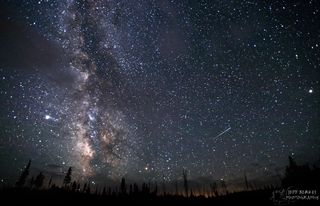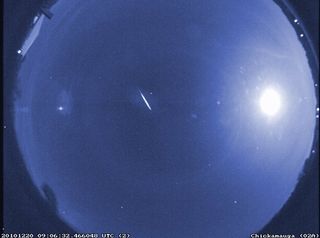Delta Aquarid Meteor Shower Peaks Tonight: How to Watch it Live Online

The Delta Aquarid meteor shower is peaking from tonight (July 28) into Tuesday (July 29), and even if you can't catch the cosmic show in person, you can still see live views of the annual shower online.
The online Slooh Community Observatory will host a webcast featuring the Delta Aquarid meteor shower as seen from Arizona and the Canary Islands off the west coast of Africa, weather permitting. Experts will also be on hand to discuss the celestial sight. You can watch the Delta Aquarid webcast here at Space.com, or you can check it out directly through Slooh.com. The live show will begin at 10 p.m. EDT tonight (0200 July 29 GMT), and you can participate in the conversation on Twitter using the hashtag #SloohShower.
Astronomers predict that the peak of the shower will produce about 16 meteors per hour, Slooh representatives said. While the Delta Aquarid shower usually isn't spectacular, this year it falls during a new moon, meaning the dim "shooting stars" should stand out against the dark night sky. Slooh is planning to use special equipment for the webcast to show as many meteors as possible. [The Best Skywatching Events of July 2014 (Gallery)]

"The results obtained by this new equipment are what's primarily fascinating," Slooh astronomer Bob Berman, who will provide commentary during the webcast, said in a statement. "We're hoping to capture more meteors than ever before, despite the modest nature of this relatively little-known shower."
NASA will also host a meteor shower webcast, if weather allows, on July 29 starting at 9:30 p.m. EDT (0130 July 30 GMT). The space agency's Delta Aquarid live stream will feature views of the shower from NASA's Marshall Space flight Center in Huntsville, Alabama. You can also watch the NASA webcast on Space.com or watch through NASA directly.
Scientists still aren't exactly sure of the origin of the Delta Aquarids, although people have started to unravel the mystery, according to Slooh representatives. Astronomers now think the meteor shower is produced when Earth travels through the debris left behind by Comet Macholtz, which was discovered in 1986.
"The slightly mysterious nature of these often-overlooked shooting stars adds to the night's fun," Berman said.
Get the Space.com Newsletter
Breaking space news, the latest updates on rocket launches, skywatching events and more!
Annual meteor showers are created when Earth passes through a field of debris left in a comet's wake. The particles sloughed off by the cosmic body burn up in the atmosphere, creating the shooting stars people see from dark places on the ground.
Editor's Note: If you snap an amazing photo of the Delta Aquarid meteor shower or any other night sky sight and would like to share it with Space.com, send images and comments to managing editor Tariq Malik at spacephotos@space.com.
Follow Miriam Kramer @mirikramer and Google+. Follow us @Spacedotcom, Facebook and Google+. Original article on Space.com.
Join our Space Forums to keep talking space on the latest missions, night sky and more! And if you have a news tip, correction or comment, let us know at: community@space.com.

Miriam Kramer joined Space.com as a Staff Writer in December 2012. Since then, she has floated in weightlessness on a zero-gravity flight, felt the pull of 4-Gs in a trainer aircraft and watched rockets soar into space from Florida and Virginia. She also served as Space.com's lead space entertainment reporter, and enjoys all aspects of space news, astronomy and commercial spaceflight. Miriam has also presented space stories during live interviews with Fox News and other TV and radio outlets. She originally hails from Knoxville, Tennessee where she and her family would take trips to dark spots on the outskirts of town to watch meteor showers every year. She loves to travel and one day hopes to see the northern lights in person. Miriam is currently a space reporter with Axios, writing the Axios Space newsletter. You can follow Miriam on Twitter.
